Intra-Cavity Raman Laser Operating at 1193 nm Based on Graded-Index Fiber
Abstract
1. Introduction
2. Experimental Setup
3. Experimental Results and Discussion
4. Conclusions
Author Contributions
Funding
Institutional Review Board Statement
Informed Consent Statement
Data Availability Statement
Acknowledgments
Conflicts of Interest
References
- Fermann, M.E.; Hartl, I. Ultrafast fiber laser technology. IEEE J. Sel. Top. Quantum Electron. 2009, 15, 191–206. [Google Scholar] [CrossRef]
- Jeong, Y.E.; Sahu, J.K.; Payne, D.A.; Nilsson, J. Ytterbium-doped large-core fiber laser with 1.36 kW continuous-wave output power. Opt. Express 2004, 12, 6088–6092. [Google Scholar] [CrossRef] [PubMed]
- Zhu, J.J.; Zhou, P.; Ma, Y.X.; Xu, X.J.; Liu, Z.J. Power scaling analysis of tandem-pumped Yb-doped fiber lasers and amplifiers. Opt. Express 2011, 19, 18645–18654. [Google Scholar] [CrossRef] [PubMed]
- Bednyakova, A.E.; Gorbunov, O.A.; Politko, M.O.; Kablukov, S.I.; Smirnov, S.V.; Churkin, D.V.; Fedoruk, M.P.; Babin, S.A. Generation dynamics of the narrowband Yb-doped fiber laser. Opt. Express 2013, 21, 8177–8182. [Google Scholar] [CrossRef] [PubMed]
- Cabasse, A.; Ortaç, B.; Martel, G.; Hideur, A.; Limpert, J. Dissipative solitons in a passively mode-locked Er-doped fiber with strong normal dispersion. Opt. Express 2008, 16, 19322–19329. [Google Scholar] [CrossRef]
- Kuhn, V.; Kracht, D.; Neumann, J.; Weßels, P. 67 W of output power from an Yb-free Er-doped fiber amplifier cladding pumped at 976 nm. IEEE Photon. Technol. Lett. 2011, 23, 432–434. [Google Scholar] [CrossRef]
- Moulton, P.F.; Rines, G.A.; Slobodtchikov, E.V.; Wall, K.F.; Frith, G.; Samson, B.; Carter, A.L. Tm-doped fiber lasers: Fundamentals and power scaling. IEEE J. Sel. Top. Quantum Electron. 2009, 15, 85–92. [Google Scholar] [CrossRef]
- Ast, S.; Nia, R.M.; Schönbeck, A.; Lastzka, N.; Steinlechner, J.; Eberle, T.; Mehmet, M.; Steinlechner, S.; Schnabel, R. High-efficiency frequency doubling of continuous-wave laser light. Opt. Lett. 2011, 36, 3467–3469. [Google Scholar] [CrossRef]
- Negel, J.P.; Loescher, A.; Voss, A.; Bauer, D.; Sutter, D.; Killi, A.; Ahmed, M.A.; Graf, T. Ultrafast thin-disk multipass laser amplifier delivering 1.4 kW (4.7 mJ, 1030 nm) average power converted to 820 W at 515 nm and 234 W at 343 nm. Opt. Express 2015, 23, 21064–21077. [Google Scholar] [CrossRef]
- Leindecker, N.; Marandi, A.; Byer, R.L.; Vodopyanov, K.L.; Jiang, J.; Hartl, I.; Fermann, M.; Schunemann, P.G. Octave-spanning ultrafast OPO with 2.6-6.1 µm instantaneous bandwidth pumped by femtosecond Tm-fiber laser. Opt. Express 2012, 20, 7046–7053. [Google Scholar] [CrossRef]
- Wu, R.F.; Lai, K.S.; Wong, H.F.; Xie, W.J.; Lim, Y.L.; Lau, E. Multiwatt mid-IR output from a Nd: YALO laser pumped intracavity KTA OPO. Opt. Express 2001, 8, 694–698. [Google Scholar] [CrossRef] [PubMed]
- Supradeepa, V.R.; Feng, Y.; Nicholson, J.W. Raman fiber lasers. J. Opt. 2017, 19, 023001. [Google Scholar] [CrossRef]
- Nicholson, J.W.; Yan, M.F.; Wisk, P.; Fleming, J.; DiMarcello, F.; Monberg, E.; Taunay, T.; Headley, C.; DiGiovanni, D.J. Raman fiber laser with 81 W output power at 1480 nm. Opt. Lett. 2010, 35, 3069–3071. [Google Scholar] [CrossRef] [PubMed]
- Supradeepa, V.R.; Nicholson, J.W. Power scaling of high-efficiency 1.5 μm cascaded Raman fiber lasers. Opt. Lett. 2013, 38, 2538–2541. [Google Scholar] [CrossRef]
- Churin, D.; Olson, J.; Norwood, R.A.; Peyghambarian, N.; Kieu, K. High-power synchronously pumped femtosecond Raman fiber laser. Opt. Lett. 2015, 40, 2529–2532. [Google Scholar] [CrossRef]
- Baek, S.H.; Roh, W.B. Single-mode Raman fiber laser based on a multimode fiber. Opt. Lett. 2004, 29, 153–155. [Google Scholar] [CrossRef]
- Xiao, Q.; Yan, P.; Li, D.; Sun, J.; Wang, X.; Huang, Y.; Gong, M. Bidirectional pumped high power Raman fiber laser. Opt. Express 2016, 24, 6758–6768. [Google Scholar] [CrossRef]
- Glick, Y.; Fromzel, V.; Zhang, J.; Ter-Gabrielyan, N.; Dubinskii, M. High-efficiency, 154 W CW, diode-pumped Raman fiber laser with brightness enhancement. Appl. Opt. 2017, 56, B97–B102. [Google Scholar] [CrossRef]
- Kuznetsov, A.G.; Kablukov, S.I.; Wolf, A.A.; Nemov, I.N.; Tyrtyshnyy, V.A.; Myasnikov, D.V.; Babin, S.A. 976 nm all-fiber Raman laser with high beam quality at multimode laser diode pumping. Laser Phys. Lett. 2019, 16, 105102. [Google Scholar] [CrossRef]
- Kuznetsov, A.G.; Evmenova, E.A.; Dontsova, E.I.; Kablukov, S.I.; Babin, S.A. Frequency doubling of multimode diode-pumped GRIN-fiber Raman lasers. Opt. Express 2019, 27, 34760–34768. [Google Scholar] [CrossRef]
- Chen, Y.A.; Yao, T.F.; Huang, L.J.; Xiao, H.; Leng, J.Y.; Zhou, P. 2 kW high-efficiency Raman fiber amplifier based on passive fiber with dynamic analysis on beam cleanup and fluctuation. Opt. Express 2020, 28, 3495–3504. [Google Scholar] [CrossRef] [PubMed]
- Fan, C.C.; Xiao, H.; Yao, T.F.; Xu, J.M.; Chen, Y.Z.; Leng, J.Y.; Zhou, P. Kilowatt level Raman amplifier based on 100 µm core diameter multimode GRIN fiber with M2 = 1.6. Opt. Lett. 2021, 46, 3432–3435. [Google Scholar] [CrossRef] [PubMed]
- Zlobina, E.A.; Kablukov, S.I.; Wolf, A.A.; Nemov, I.N.; Dostovalov, A.V.; Tyrtyshnyy, V.A.; Myasnikov, D.V.; Babin, S.A. Generating high-quality beam in a multimode LD-pumped all-fiber Raman laser. Opt. Express 2017, 25, 12581–12587. [Google Scholar] [CrossRef]
- Lombard, L.; Brignon, A.; Huignard, J.P.; Lallier, E.; Georges, P. Beam cleanup in a self-aligned gradient-index Brillouin cavity for high-power multimode fiber amplifiers. Opt. Lett. 2006, 31, 158–160. [Google Scholar] [CrossRef] [PubMed]
- Podivilov, E.V.; Kharenko, D.S.; Gonta, V.A.; Krupa, K.; Sidelnikov, O.S.; Turitsyn, S.; Fedoruk, M.P.; Babin, S.A.; Wabnitz, S. Hydrodynamic 2D turbulence and spatial beam condensation in multimode optical fibers. Phys. Rev. Lett. 2019, 122, 103902. [Google Scholar] [CrossRef] [PubMed]
- Flusche, B.M.; Alley, T.G.; Russell, T.H.; Roh, W.B. Multi-port beam combination and cleanup in large multimode fiber using stimulated Raman scattering. Opt. Express 2006, 14, 11748–11755. [Google Scholar] [CrossRef] [PubMed]
- Chiang, K.S. Stimulated Raman scattering in a multimode optical fiber: Evolution of modes in Stokes waves. Opt. Lett. 1992, 17, 352–354. [Google Scholar] [CrossRef]
- Bruesselbach, H. Beam cleanup using stimulated Brillouin scattering in multimode fibers. In Proceedings of the Conference on Lasers and Electro-Optics, Baltimore, MD, USA, 2–7 May 1993; Optical Society of America: Washington, DC, USA, 1993; p. CThJ2. [Google Scholar]
- Niang, A.; Modotto, D.; Tonello, A.; Mangini, F.; Minoni, U.; Zitelli, M.; Fabert, M.; Jima, M.A.; Egorova, O.N.; Levchenko, A.E.; et al. Spatial beam self-cleaning in tapered Yb-doped GRIN multimode fiber with decelerating nonlinearity. arXiv 2019, arXiv:2001.00105. [Google Scholar] [CrossRef]
- Wu, H.; Wang, Z.N.; He, Q.H.; Sun, W.; Rao, Y.J. Common-cavity ytterbium/Raman random distributed feedback fiber laser. Laser Phys. Lett. 2017, 14, 065101. [Google Scholar] [CrossRef]
- Chen, L.J.; Song, R.; Lei, C.M.; Yang, W.Q.; Hou, J. Random fiber laser directly generates visible to near-infrared supercontinuum. Opt. Express 2019, 27, 29781–29788. [Google Scholar] [CrossRef]
- Song, J.X.; Ren, S.; Liu, W.; Li, W.; Wu, H.; Ma, P.F.; Zhang, H.W.; Zhou, P. Temporally stable fiber amplifier pumped random distributed feedback Raman fiber laser with record output power. Opt. Lett. 2021, 46, 5031–5034. [Google Scholar] [CrossRef] [PubMed]
- Turitsyn, S.K.; Babin, S.A.; El-Taher, A.E.; Harper, P.; Churkin, D.V.; Kablukov, S.I.; Ania-Castañón, J.D.; Karalekas, V.; Podivilov, E.V. Random distributed feedback fibre laser. Nat. Photonics 2010, 4, 231–235. [Google Scholar] [CrossRef]
- Babin, S.A.; Vatnik, I.D.; Laptev, A.Y.; Bubnov, M.M.; Dianov, E.M. High-efficiency cascaded Raman fiber laser with random distributed feedback. Opt. Express 2014, 22, 24929–24934. [Google Scholar] [CrossRef] [PubMed]
- Zhang, H.W.; Huang, L.; Song, J.X.; Wu, H.; Zhou, P.; Wang, X.L.; Wu, J.; Xu, J.M.; Wang, Z.N.; Xu, X.J.; et al. Quasi-kilowatt random fiber laser. Opt. Lett. 2019, 44, 2613–2616. [Google Scholar] [CrossRef]
- Zhang, H.X.; Fan, Y.; Pei, P.; Sun, C.X.; Lu, L.F.; Zhang, F. Tm3+-Sensitized NIR-II Fluorescent Nanocrystals for In Vivo Information Storage and Decoding. Angew. Chem. Int. Ed. 2019, 58, 10153–10157. [Google Scholar] [CrossRef] [PubMed]
- Dou, K.; Feng, W.Q.; Fan, C.; Cao, Y.; Xiang, Y.H.; Liu, Z.H. Flexible designing strategy to construct activatable NIR-II fluorescent probes with emission maxima beyond 1200 nm. Anal. Chem. 2021, 93, 4006–4014. [Google Scholar] [CrossRef] [PubMed]
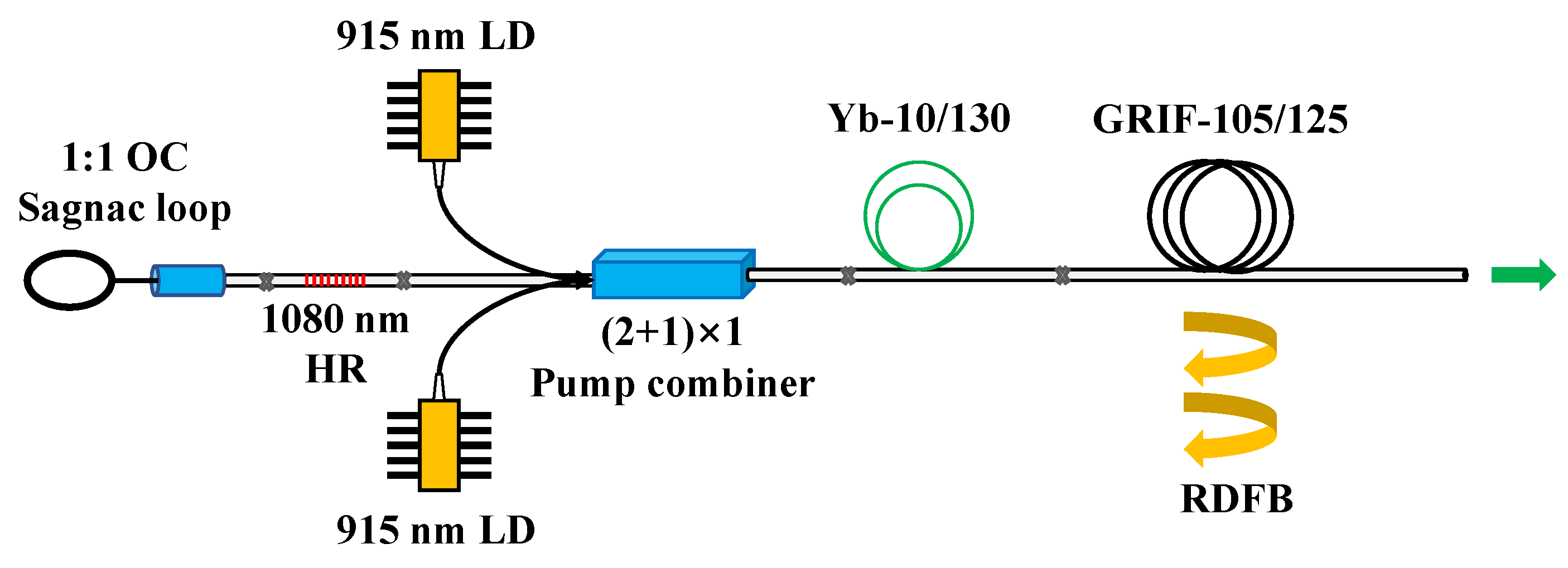
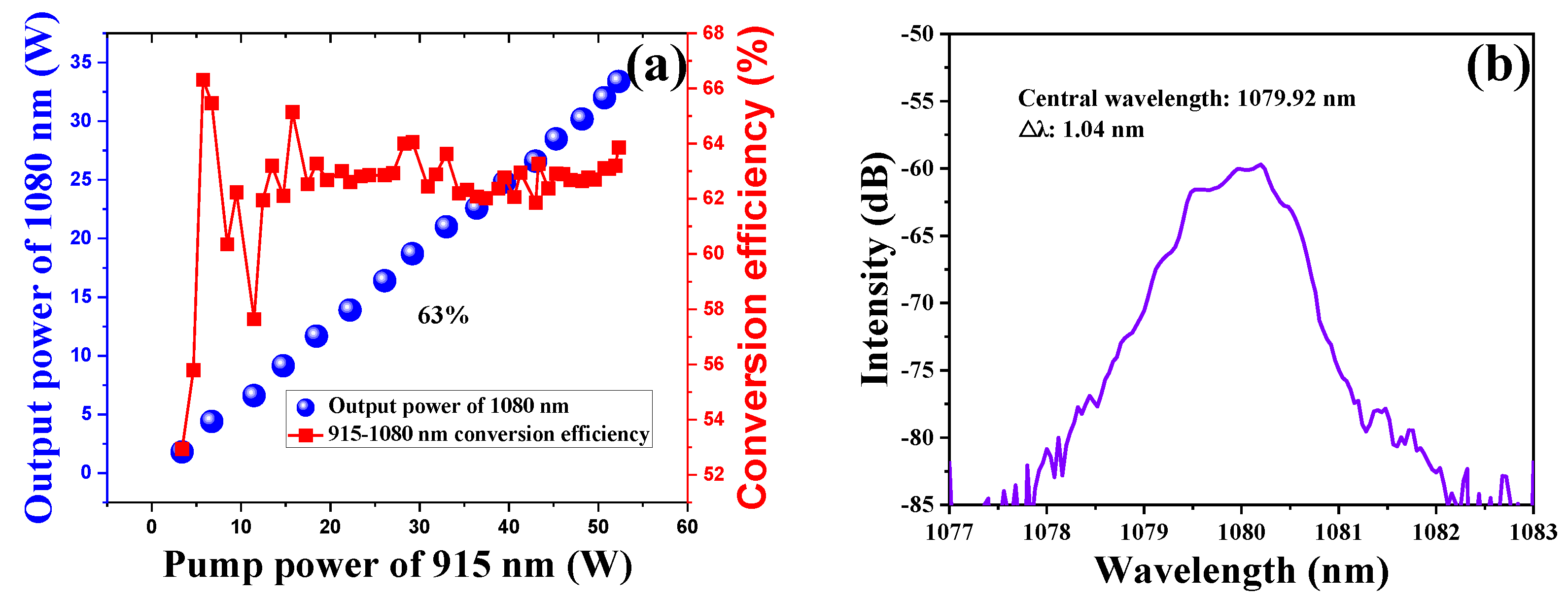
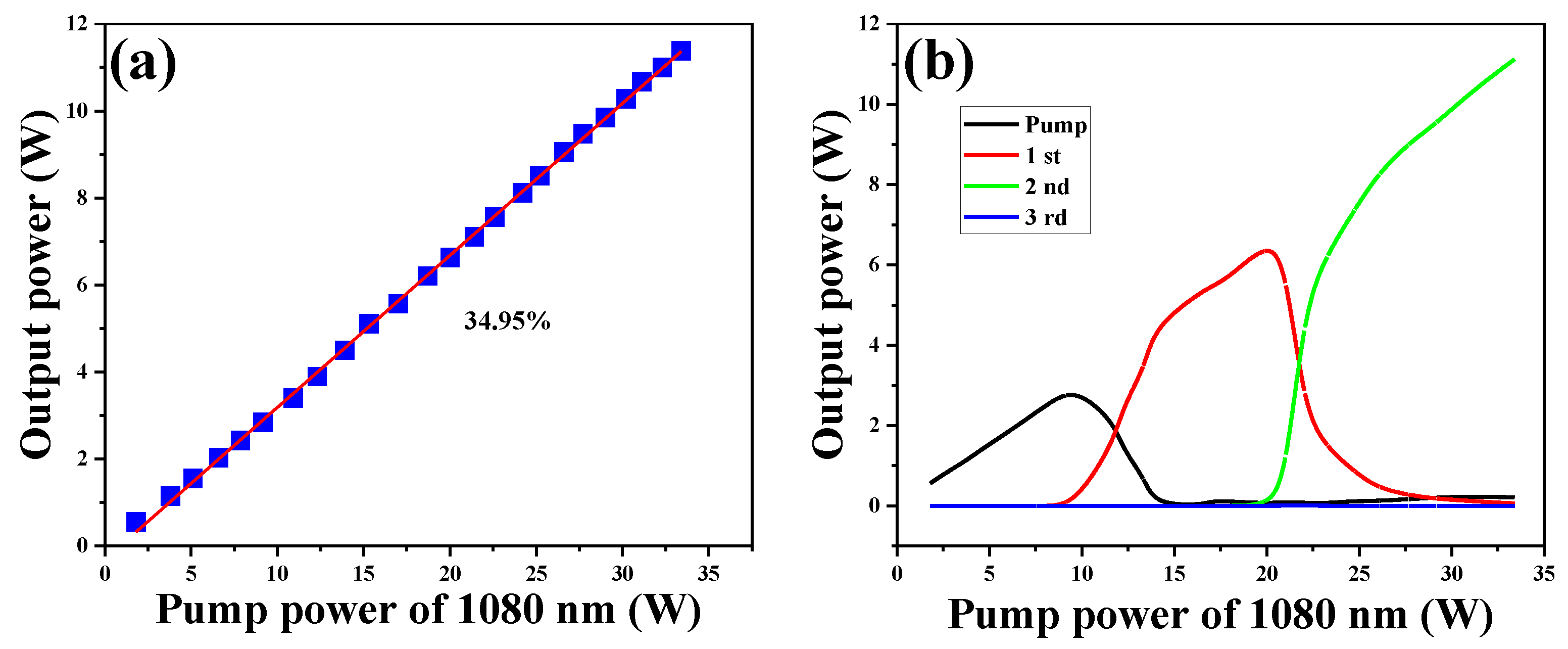
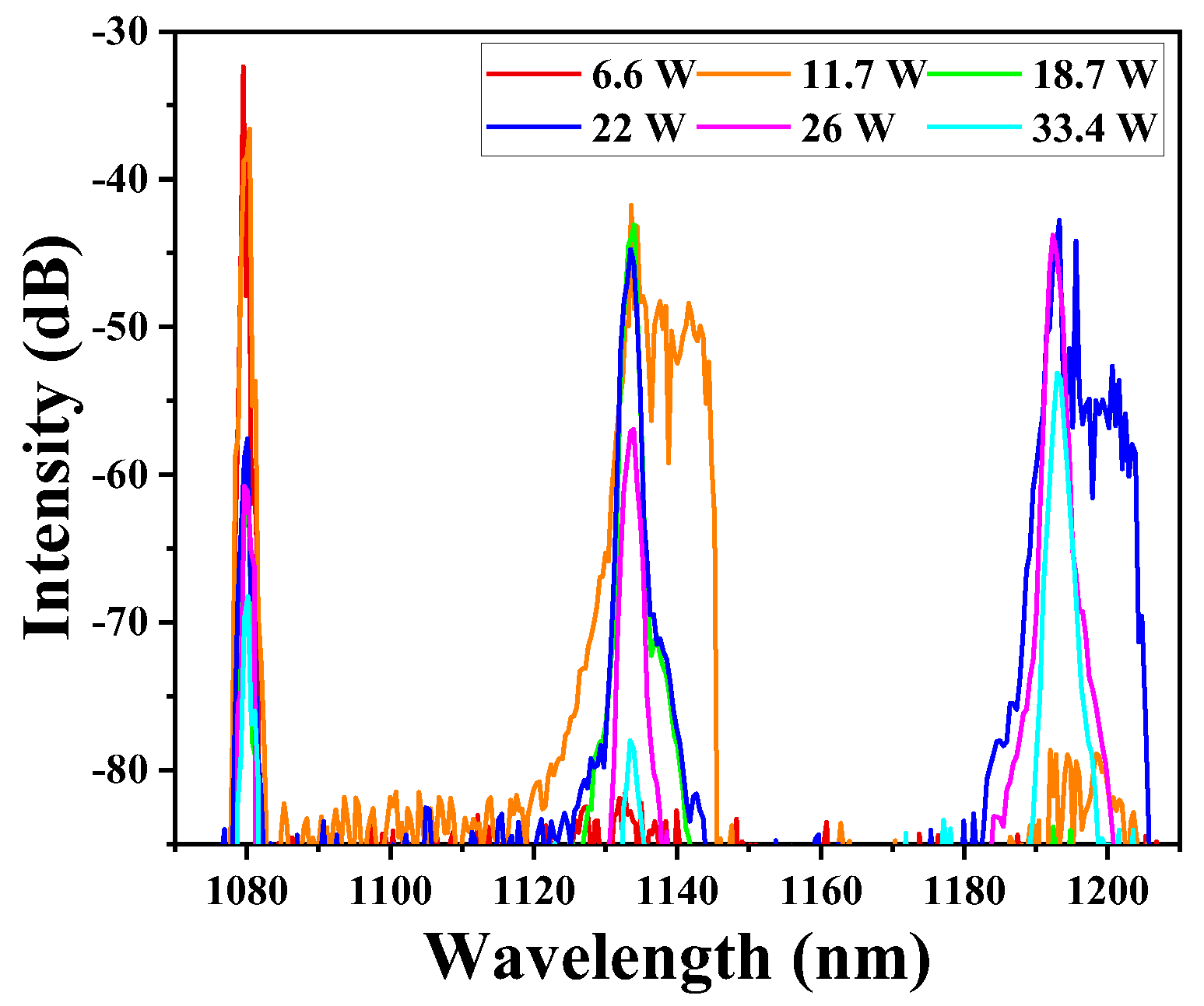
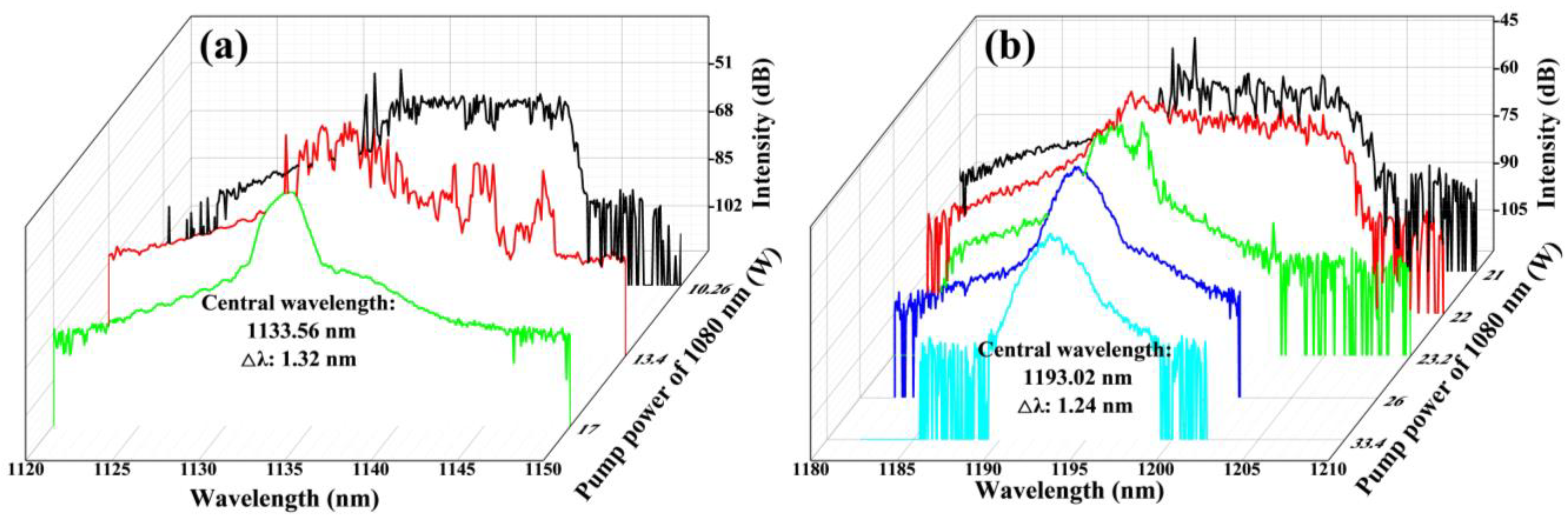
Disclaimer/Publisher’s Note: The statements, opinions and data contained in all publications are solely those of the individual author(s) and contributor(s) and not of MDPI and/or the editor(s). MDPI and/or the editor(s) disclaim responsibility for any injury to people or property resulting from any ideas, methods, instructions or products referred to in the content. |
© 2022 by the authors. Licensee MDPI, Basel, Switzerland. This article is an open access article distributed under the terms and conditions of the Creative Commons Attribution (CC BY) license (https://creativecommons.org/licenses/by/4.0/).
Share and Cite
Hu, C.; Sun, P. Intra-Cavity Raman Laser Operating at 1193 nm Based on Graded-Index Fiber. Photonics 2023, 10, 33. https://doi.org/10.3390/photonics10010033
Hu C, Sun P. Intra-Cavity Raman Laser Operating at 1193 nm Based on Graded-Index Fiber. Photonics. 2023; 10(1):33. https://doi.org/10.3390/photonics10010033
Chicago/Turabian StyleHu, Chunhua, and Ping Sun. 2023. "Intra-Cavity Raman Laser Operating at 1193 nm Based on Graded-Index Fiber" Photonics 10, no. 1: 33. https://doi.org/10.3390/photonics10010033
APA StyleHu, C., & Sun, P. (2023). Intra-Cavity Raman Laser Operating at 1193 nm Based on Graded-Index Fiber. Photonics, 10(1), 33. https://doi.org/10.3390/photonics10010033



